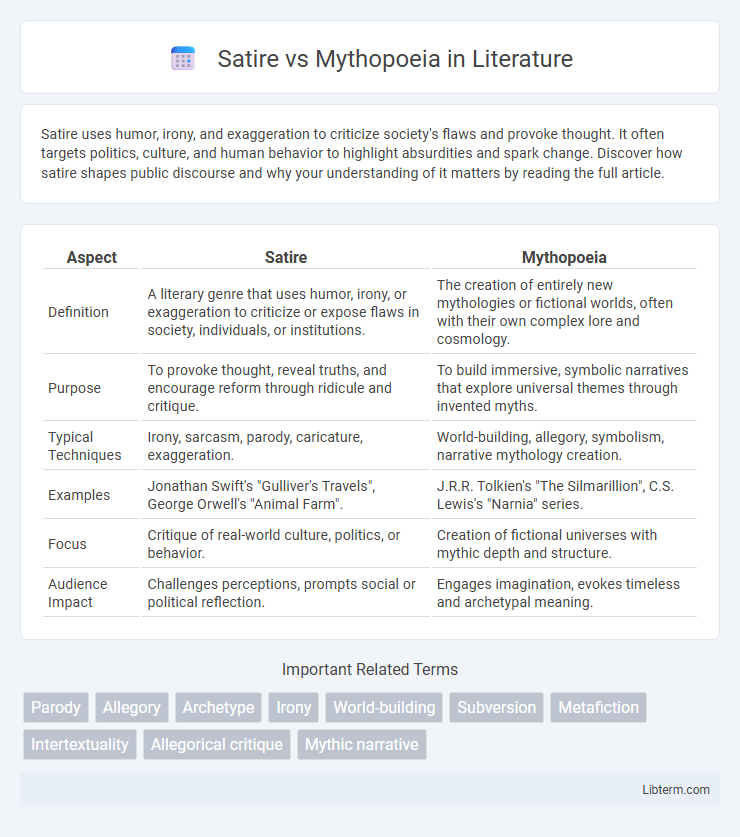Satire uses humor, irony, and exaggeration to criticize society's flaws and provoke thought. It often targets politics, culture, and human behavior to highlight absurdities and spark change. Discover how satire shapes public discourse and why your understanding of it matters by reading the full article.
Table of Comparison
| Aspect | Satire | Mythopoeia |
|---|---|---|
| Definition | A literary genre that uses humor, irony, or exaggeration to criticize or expose flaws in society, individuals, or institutions. | The creation of entirely new mythologies or fictional worlds, often with their own complex lore and cosmology. |
| Purpose | To provoke thought, reveal truths, and encourage reform through ridicule and critique. | To build immersive, symbolic narratives that explore universal themes through invented myths. |
| Typical Techniques | Irony, sarcasm, parody, caricature, exaggeration. | World-building, allegory, symbolism, narrative mythology creation. |
| Examples | Jonathan Swift's "Gulliver's Travels", George Orwell's "Animal Farm". | J.R.R. Tolkien's "The Silmarillion", C.S. Lewis's "Narnia" series. |
| Focus | Critique of real-world culture, politics, or behavior. | Creation of fictional universes with mythic depth and structure. |
| Audience Impact | Challenges perceptions, prompts social or political reflection. | Engages imagination, evokes timeless and archetypal meaning. |
Defining Satire: Purpose and Techniques
Satire employs irony, exaggeration, and humor to expose and critique human follies, societal norms, and political corruption, aiming to provoke reflection and reform. Its techniques include parody, sarcasm, and inversion, which highlight contradictions and absurdities in behavior or institutions. The purpose of satire is not merely entertainment but fostering awareness through pointed, often humorous social commentary.
What is Mythopoeia? Origins and Significance
Mythopoeia, a literary genre coined by J.R.R. Tolkien, involves the creation of entire mythologies through original fictional narratives. Originating from the Greek terms "mythos" (myth) and "poiein" (to make), mythopoeia transforms storytelling into a deliberate act of crafting complex, symbolic worlds that often express universal truths or cultural archetypes. Its significance lies in enriching literature by providing immersive, self-contained universes that explore fundamental human experiences and existential themes beyond mere entertainment.
Historical Contexts: Satire and Mythopoeia Through Time
Satire has historically served as a tool for societal critique, originating in ancient Greek and Roman literature with figures like Aristophanes and Juvenal who used humor to expose political and social follies. Mythopoeia, exemplified by works such as Tolkien's Middle-earth saga, emerged primarily in the 20th century as a method for creating new mythologies that explore universal themes and human experience. Both genres evolved through distinct historical contexts, with satire reacting to its contemporary political climate and mythopoeia responding to modernity's loss of traditional mythic narratives.
Core Differences: Satire vs Mythopoeia
Satire employs humor, irony, and exaggeration to critique societal flaws and provoke change, targeting real-world issues and human behavior. Mythopoeia constructs entirely new mythologies or fictional universes, aiming to explore themes through imaginative world-building and symbolic narratives. While satire reflects and challenges reality, mythopoeia creates alternative realities to convey deeper philosophical or cultural meanings.
Common Themes: Overlaps and Divergence
Satire and mythopoeia often explore themes of power, morality, and human nature, using narrative to critique societal flaws or construct alternative realities. Both genres employ symbolism and allegory to convey deeper meanings, yet satire emphasizes irony and humor to expose follies, while mythopoeia crafts elaborate mythic worlds to evoke timeless truths. The divergence lies in satire's focus on contemporary social commentary versus mythopoeia's goal of creating enduring fictional mythologies.
Influential Satirical Works and Their Impact
Jonathan Swift's "Gulliver's Travels" exemplifies influential satire, using exaggerated voyages to critique contemporary politics and human nature, shaping modern satirical literature. George Orwell's "Animal Farm" stands as a powerful satirical allegory exposing totalitarianism through a fable about farm animals, impacting political discourse and popular culture. These works demonstrate satire's ability to provoke critical thought and social change by blending humor with incisive commentary.
Landmark Mythopoeic Texts in Literature
Landmark mythopoeic texts such as J.R.R. Tolkien's "The Lord of the Rings" and C.S. Lewis's "The Chronicles of Narnia" create intricate secondary worlds built on original mythologies, emphasizing imaginative world-building and symbolic depth. Satire, exemplified by Jonathan Swift's "Gulliver's Travels," employs irony and humor to critique society, politics, or human nature rather than constructing wholly new mythic realities. These mythopoeic works focus on foundational myths that explore universal themes and archetypes, contrasting with satire's aim to provoke thought through social commentary and parody.
Narrative Structures: Parody vs World-Building
Satire employs narrative structures centered on parody, exaggerating real-world traits and flaws to critique societal issues through humor and irony. Mythopoeia builds immersive worlds with intricate lore and consistent internal logic, crafting myth-like narratives that transport readers beyond reality. While satire deconstructs existing paradigms, mythopoeia constructs new universes that explore universal themes through original mythology.
Contemporary Uses: Satire and Mythopoeia Today
Contemporary satire sharply critiques social and political issues through humor, irony, and exaggeration, with platforms like television shows, online content, and literature driving public discourse and awareness. Mythopoeia in modern storytelling crafts immersive fictional universes and cultural myths, seen prominently in works by authors like Neil Gaiman and in franchises such as Marvel and Star Wars, enriching cultural narratives and identity. Both genres influence contemporary media by shaping perspectives: satire challenges societal norms, while mythopoeia builds imaginative worlds that reflect complex human experiences.
The Future of Satire and Mythopoeia in Popular Culture
The future of satire in popular culture hinges on its ability to adapt to rapidly evolving social and digital landscapes, leveraging sharp critique to challenge political and cultural norms through platforms like social media and streaming services. Mythopoeia's resurgence is driven by a growing appetite for complex, immersive narratives that blend ancient mythological motifs with contemporary themes, seen prominently in multimedia franchises such as Marvel and The Witcher. Both forms influence storytelling dynamics by balancing critical reflection and imaginative world-building, shaping audience engagement in the 21st century.
Satire Infographic

 libterm.com
libterm.com